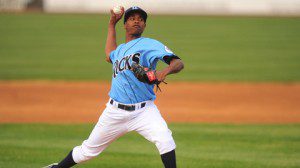
On day, two states, three games, 11 hours of baseball. That’s what my half-day at work was like Saturday, and that’s what it takes to see “The Spectrum.” It’s what it takes to see the continuum of promise and waste that’s littered across the abyss of minor league baseball. During this day, I saw a phenom, a ghost, an enigma, a surprise, a sloth and every type of minor league baseball player you can think of in between. From 19-year-old kids who barely have to shave to a 30-something vet who’d bolt for Korea days later, a day full of minor league baseball makes your heart sink with pity one minute and sets it a flutter with intrigue the next. Here’s a taste of what I witnessed:
Dylan Bundy (BAL)
The best prospect left in the minors, Bundy created a ton of buzz thanks to his dominance at low-A where he rarely gave up a base runner. He was promoted to high-A where he continues to make hitters look silly as they flail at high fastballs and hack foolishly away at curveballs in the dirt. Bundy sat at 95-96 mph and touched 98 mph with his fastball. He gets good plane on it for his size (he’s only about 6’-1”) thanks to his nearly directly over-the-top arm angle. He’ll throw the already above-average curveball for strikes and bury it for swings and misses. The change-up is fine but plays up when 20-year-old kids are gearing up for plus-plus heat. Bundy relies too much on inducing bad swings at chest high fastballs. He’d probably even get away with it at double-A. But when it comes time to pitch to big-boy major league hitters, he’s going to have to use other means. Not everyone is Hunter Pence.
Oh, and Bundy will pitch for two decades if he stays in the shape he’s in now. His lower half, which he uses with extraordinary efficiency, looks like that of Brian Westbrook or Barry Sanders. He’s going to be a monster when he polishes up.
Yordano Ventura (KC)
Just as much heat as Bundy but far less feel for it, Royals howitzer Ventura profiles best in a bullpen. The fastball sits mid-90s touching 99 mph with a ton of life when he throws it arm side. The sweeping curveball flashes plus and he even threw a good change-up or two. But Ventura’s diminutive stature and well-below-average control are going to relegate him to a bullpen where his velocity might even tick up a bit. He’ll be a scary, late-inning pen arm. Scary for both opposing teams and his own, for he’ll surely have outings that would make Carlos Marmol blush.
Cheslor Cuthbert (KC)
The Nicaraguan third baseman made a ton of noise late last year, and the fact that the Royals even thought he could handle high-A ball at his age is impressive. But it seems like something’s wrong. Lethargic in the field, imbalanced at the plate, I didn’t leave Wilmington a Cuthbert fan. The bat speed is there but it’s a pull-happy swing that will be exploited at higher levels. He almost seems disinterested. Hope he goes to work on his deficiencies, but I’m sour on Cheslor.
Domonic Brown (PHI)
I’ve already written at length about Brown, but I should note that he’s had a monster week and a half since I wrote what could be considered his prospect eulogy. Boy, I hope he keeps it up.
Mark Prior (BOS)
It was surreal to see Prior jog to the Coca Cola park mound. Wiry thin and noticeably older even from afar, it took him a while to loosen up on the mound even after warming for a while in the bullpen. He sat 88-89 mph early in his inning before amping up to 92-93 mph late. There’s nothing wrong with that, but the secondary stuff was unimpressive. He garnered a few embarrassing swings with the curveball, but good major league hitters will surely pick up the differences in arm speed and release he displayed, especially since I could. Seventh-grade me was all about Mark Prior, and I hope he finds a way into Boston’s bullpen. If you’re not rooting for him, check your pulse.
Tuffy Gosewisch (PHI)
Tuffy had been a great minor league defensive catcher for years. The Arizona State grad is exactly the sort of player you’d love to have in your system. No, he’s not a prospect, but he works hard, is a treat for your young pitchers to work with and doesn’t pout because he’s unlikely to get to the majors. He’s making a living playing baseball, and that’s good enough for him. But it appears that, over the offseason, Tuffy discovered Tasty Cakes or something. He’s no longer the agile, ball-blocking, pitch-framing machine he’d been for the past half decade. It’s marginal, but it doesn’t do your teammates any favors. It’s one less reason for you to be around. Stay in shape, kids.
Steven Susdorf (PHI)
I haven’t seen anyone track the ball out of the pitcher’s hand this year like Susdorf does. He can flat out hit. He’s small and there’s barely any power there, so pitchers are going to challenge him, forcing him to put the ball in play instead of drawing walks, so that will limit his on-base skills. But, if he can play good defense at any outfield spot then there’s a place for him on my NL bench as a fine pinch hitting fourth outfielder. Embrace the Dorf.
